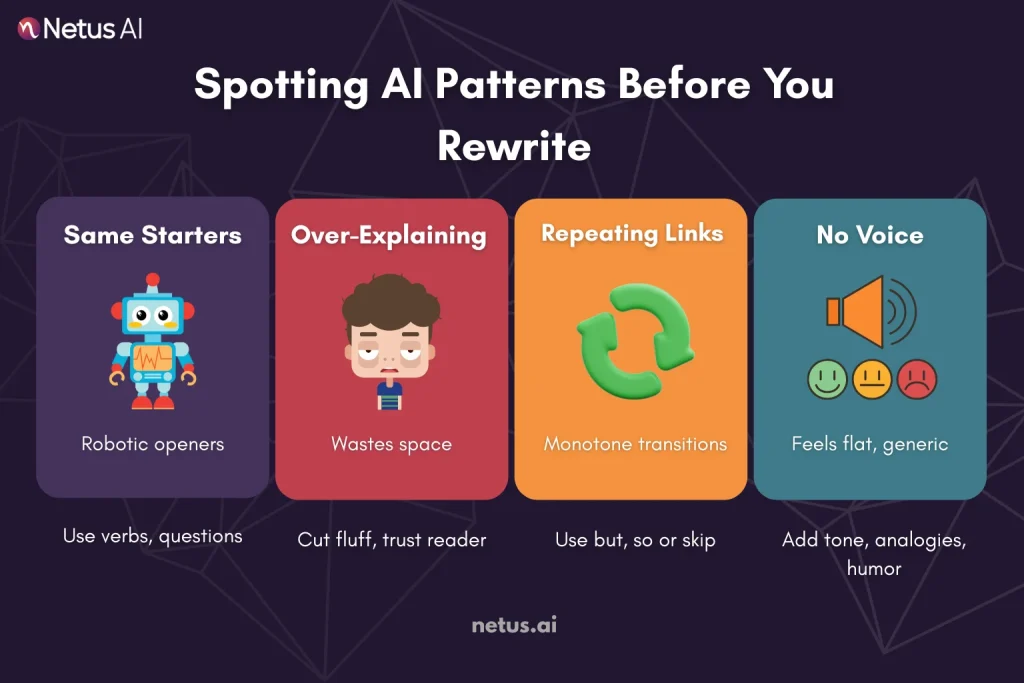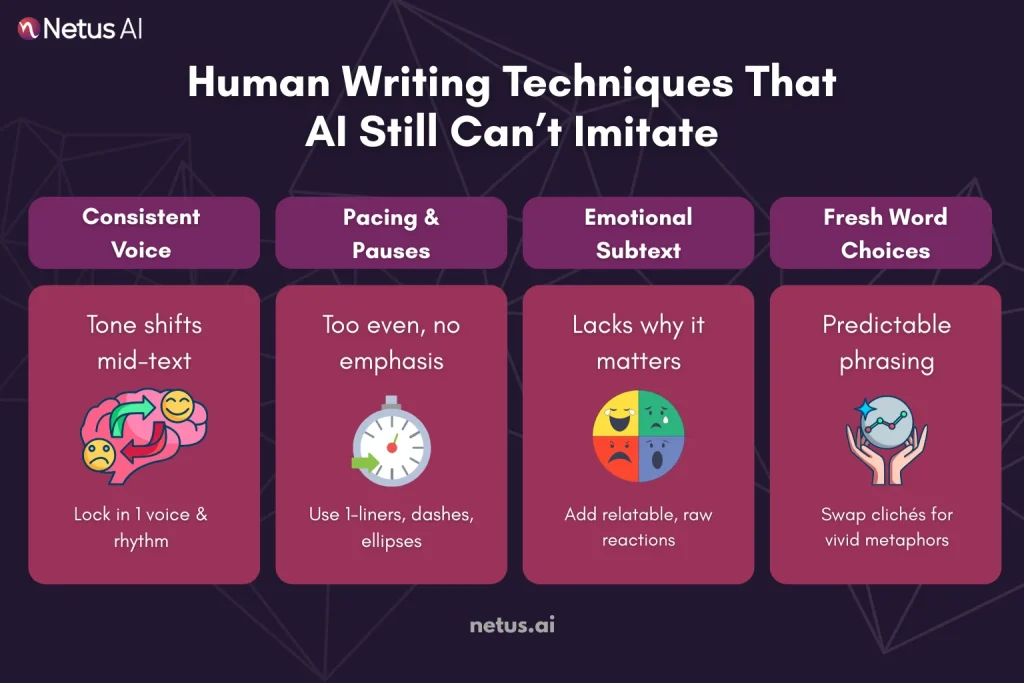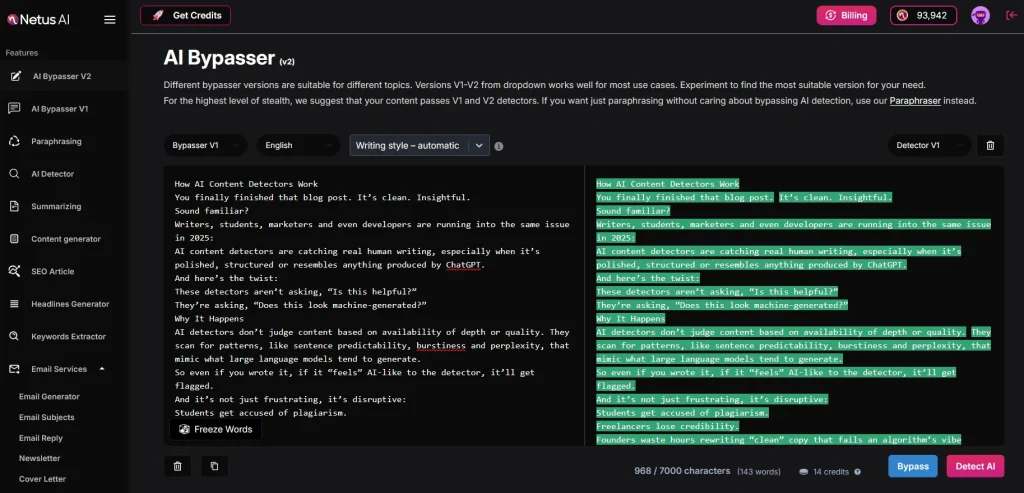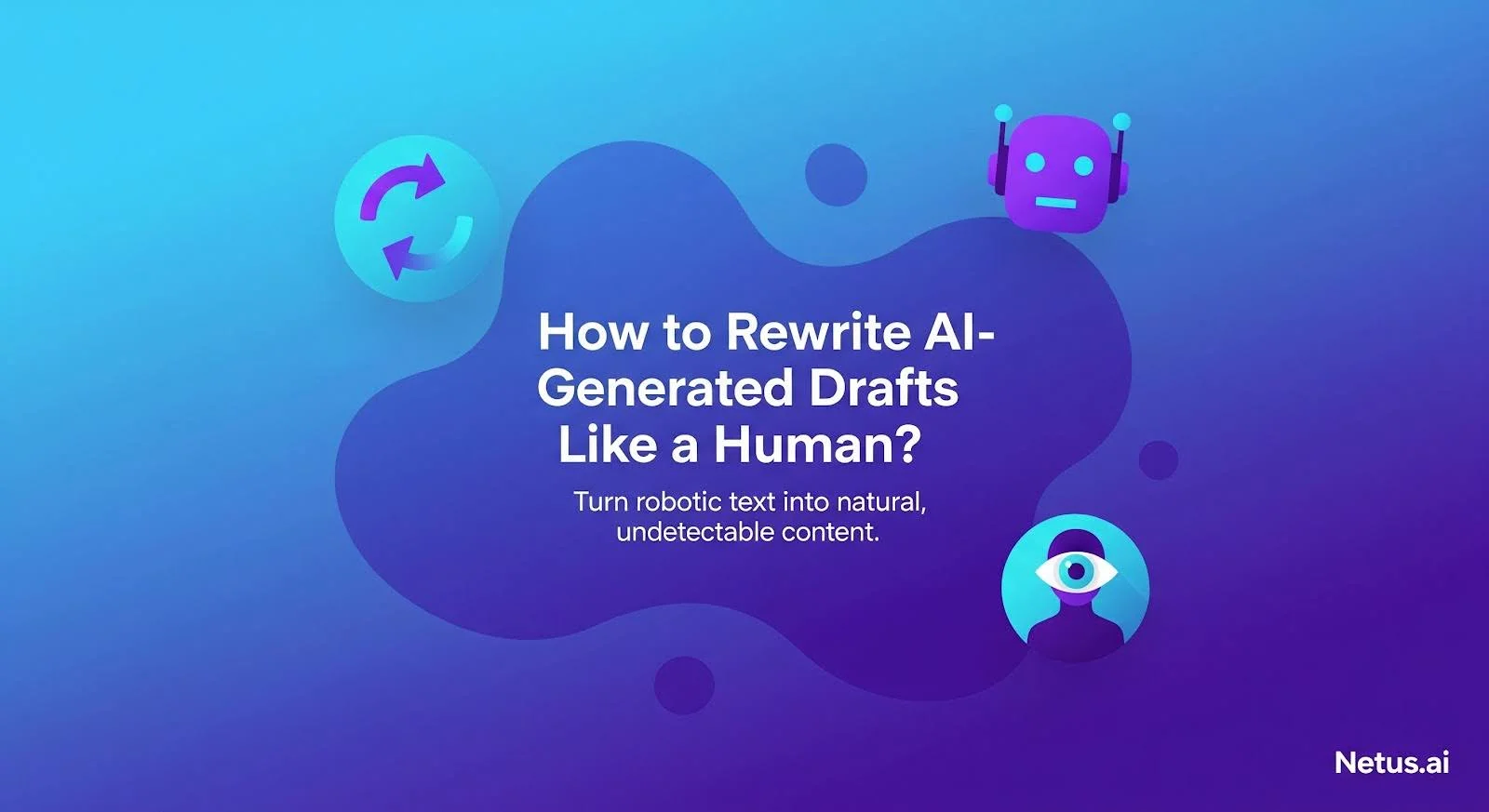You’ve probably used AI to whip up a blog post or outline, maybe even this week. It’s fast, it’s structured and it sounds okay.
But “okay” doesn’t cut it when you’re trying to rank, persuade or sound like you.
AI content often lacks authenticity despite meeting surface-level requirements. Readers can sense when it feels robotic.
AI detectors now flag well-edited content that follows predictable patterns, safe phrasing, common transitions, or flat sentence rhythms.
This is where humanizing your AI drafts comes in. Not just editing for style, but rewriting with purpose, unpredictability and clarity. Think of AI as your co-writer, not your ghostwriter.
Spotting AI Patterns Before You Rewrite

Rewriting AI content involves identifying artificial patterns, not just changing words.
Understanding how AI writes gives you an advantage when editing. AI content is grammatically correct but often lacks human nuance, rhythm, and voice.
1. Predictable Sentence Starters
AI writing loves structure. That’s why you’ll often see it begin sentences with formal, mechanical phrases like:
- “In conclusion”
- “It is important to note that”
- “This means that”
These phrases are repetitive, overly formal, and make your content sound like a textbook.
Vary your sentence openings. Start with action words, questions or more conversational phrases. Breaking predictable patterns instantly makes your content feel more dynamic.
2. Over-Explaining the Obvious
AI is trained to be thorough, but that often leads to bloated explanations. You might find multiple sentences explaining something any human reader would already understand.
This not only wastes space but also makes your writing feel clunky and robotic.
Trust your reader. If a sentence doesn’t add new insight or move the narrative forward, cut it. The best human writing respects attention spans.
3. Repetitive Transitions and Linking Words
AI overuses words like “furthermore,” “moreover,” and “in addition,” making text monotonous and artificial.
Switch to casual connectors like and, but, even so or skip transitions entirely when the flow allows it. Humans don’t link every idea with a formal signpost.
4. Lack of Voice or Point of View
Perhaps the biggest giveaway? AI plays it safe. It avoids opinion, emotion or personal takeaways, the very things that give writing personality.
Even in professional content, readers crave a sense of voice, humor or empathy. Without it, the writing feels sterile.
Read Like a Machine to Write Like a Human
Before editing, critically assess the draft: Is it too perfect, does it sound natural, and is it engaging? If it seems written for a detector, not a human, rewrite it.
Human Writing Techniques That AI Still Can’t Imitate

AI lacks emotional depth, nuance, and original thought. This is where human rewriting excels.
1. Voice and Tone Consistency
AI can mimic tone, but it often mixes styles or shifts awkwardly mid-text. Humans, on the other hand, naturally maintain a coherent voice throughout.
Before starting, establish your brand voice (e.g., casual, expert, bold). Maintain consistent vocabulary, sentence rhythm, and emotional tone throughout the draft.
Most AI rewriting tools fail here. A smart AI humanizer like NetusAI can help rewrite sections that break your tone without an artificial reset.
2. Strategic Pacing and Pauses
AI tends to output writing that feels too even, like a metronome. Human writers break rhythm to emphasize points, ask questions or create suspense.
For impactful writing: use one-sentence paragraphs, ellipses for suspense, and dashes for interruptions.
These create rhythmic variation that feels alive. AI detectors often rely on monotonous structure as a red flag, so this tactic also improves undetectability.
3. Emotional Insight and Subtext
This is where machines hit their wall. AI can say what happened. Only humans can explain why it mattered.
- Relatability: “We’ve all been there.”
- Curiosity: “What if you did the opposite?”
- Frustration: “Honestly, I almost gave up.”
Embedding genuine emotion makes writing more human and harder for AI detection tools to flag.
4. Unexpected Word Choices
Language models are built to predict the most likely next word. But that’s exactly why their writing often feels stale.
- “Mission-critical” replaces “very important.”
- “Draw your line in the sand” replaces “make a choice.”
- “A buffet of useful tricks” replaces “many features.”
Even subtle shifts like this make your text stand out, not just to readers, but to AI detectors as well.
5. Controlled Imperfection
Typos? No thanks. But intentional looseness in sentence structure can help you sound more real.
Use contractions. Start sentences with “And” or “But.” Allow thoughts to trail off if appropriate for tone.
Polish matters, but rawness = authenticity. Controlled imperfections make it clear a real human is behind the screen.
Use AI Tools the Right Way

A lot of people think grammar checkers or basic paraphrasing tools are enough to make AI writing sound more human. But that’s a bit too simple.
HumanizeAI and Smodin only skim the surface of AI writing problems. They don’t quite catch deeper issues like weird phrasing, clunky flow, or saying the same thing over and over.
To truly make AI-generated text undetectable, you need tools built specifically for that challenge.
NetusAI is an all-in-one engine that integrates detection, rewriting, and humanization in a single workflow.
Here’s how to use tools like this effectively:

Adopt the Test > Tweak > Retest Method
Drop your content into NetusAI for an instant “Human” vs. “Detected” score instead of rewriting entire drafts blindly.
From there, identify weak sections, rewrite just those parts and test again. This iteration loop makes your editing process smarter and faster.
Targeted Humanization, Not Total Rewrites
NetusAI helps identify and strengthen risky sections in AI-generated drafts, preserving your authentic voice against automated detection.
Basically, with tools like NetusAI, you can:
- Scan your content in real-time
- See which parts are triggering red flags
- Rewrite just those blocks using AI bypass engines
- Rescan until you hit “Human”
Real-Time Feedback That Guides Your Rewrites
Receive real-time feedback on rewrites, eliminating guesswork and ensuring content avoids flagging. You control the detection rating with each adjustment.
Why It Matters
Using the right tool the right way transforms your workflow:
- You spend less time rewriting entire drafts
- You maintain content quality and voice
- You produce AI-safe content that still reads like you
NetusAI humanizes AI drafts with AI detection, smart paraphrasing, summarizing, plagiarism-free content, and version tracking in one platform.
Final Thoughts
Rewriting AI content isn’t about hiding, it’s about restoring voice, nuance and trust.
AI is great for drafts, but publishing its raw output risks credibility, engagement, and even SEO penalties. Instead of abandoning AI, learn to rewrite its output to sound human:
- Keep your tone varied and natural.
- Make sure ideas connect like a real person would explain them.
- Don’t fear imperfection, embrace a bit of messiness.
Tools like NetusAI don’t just rewrite content, they give you a feedback loop to improve it until it reads like you wrote it. And that’s the real win.
FAQs
AI detectors analyze patterns, not truth. Content with AI-generated structures (repetition, uniform tone, predictable phrasing) may be flagged, even if factual.
Paraphrasing rewrites; humanizing rethinks. Effective humanization involves restructuring, tone shifts, idea injection, and natural flow, qualities beyond standard paraphrasers.
To avoid AI detection, you’ll want to make some significant changes to the phrasing, rhythm, and vocabulary. Humanized, manually reviewed, or AI-humanized content is more likely to be approved.
If you rewrite AI drafts with your voice and style, it becomes your content. AI is an assistant, not a ghostwriter.
Yes, if you’re transparent with your process and contribute original insights. Using AI responsibly, combined with thoughtful rewriting, isn’t cheating, it’s optimizing. Tools like NetusAI help streamline this workflow without compromising integrity.
Hybrid AI-human workflows, using AI for drafts and human rewriting for quality, save time. Avoid over-reliance on copy-paste.
NetusAI offers real-time detection and humanization tools. Paste your draft, run a check, and rewrite only what’s needed. It’s perfect for creators seeking fast feedback without sacrificing tone or control.





